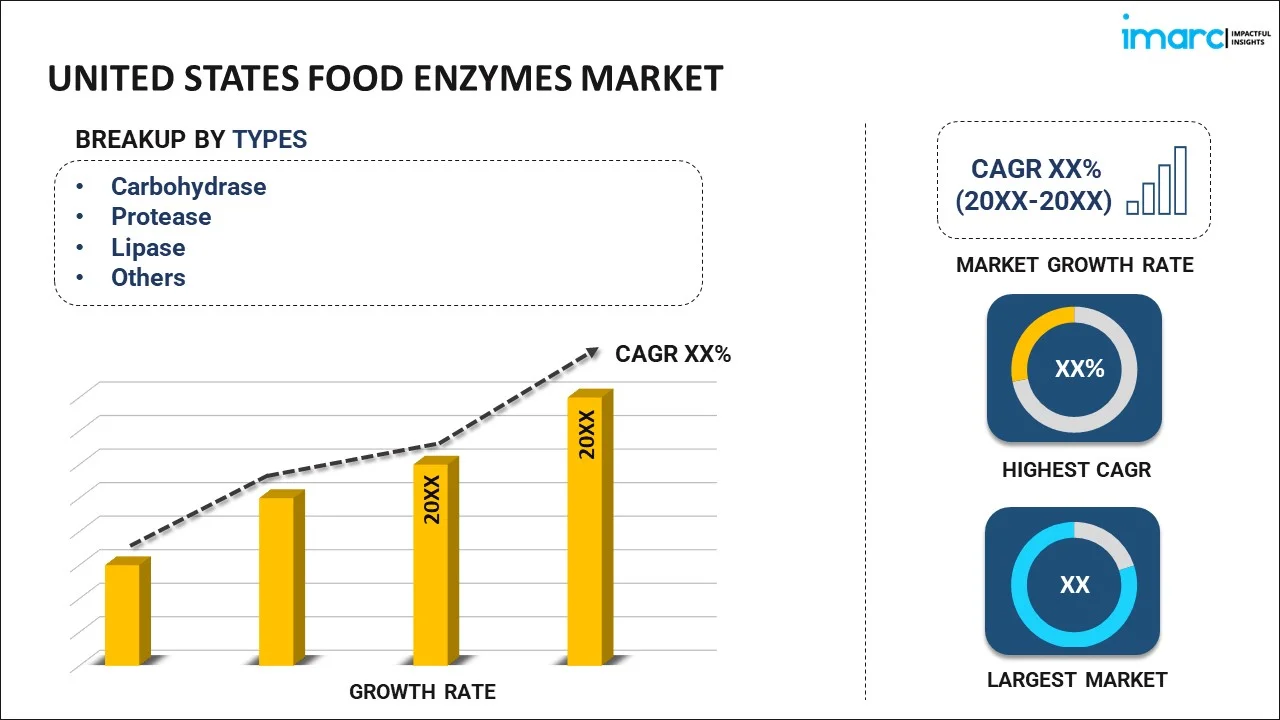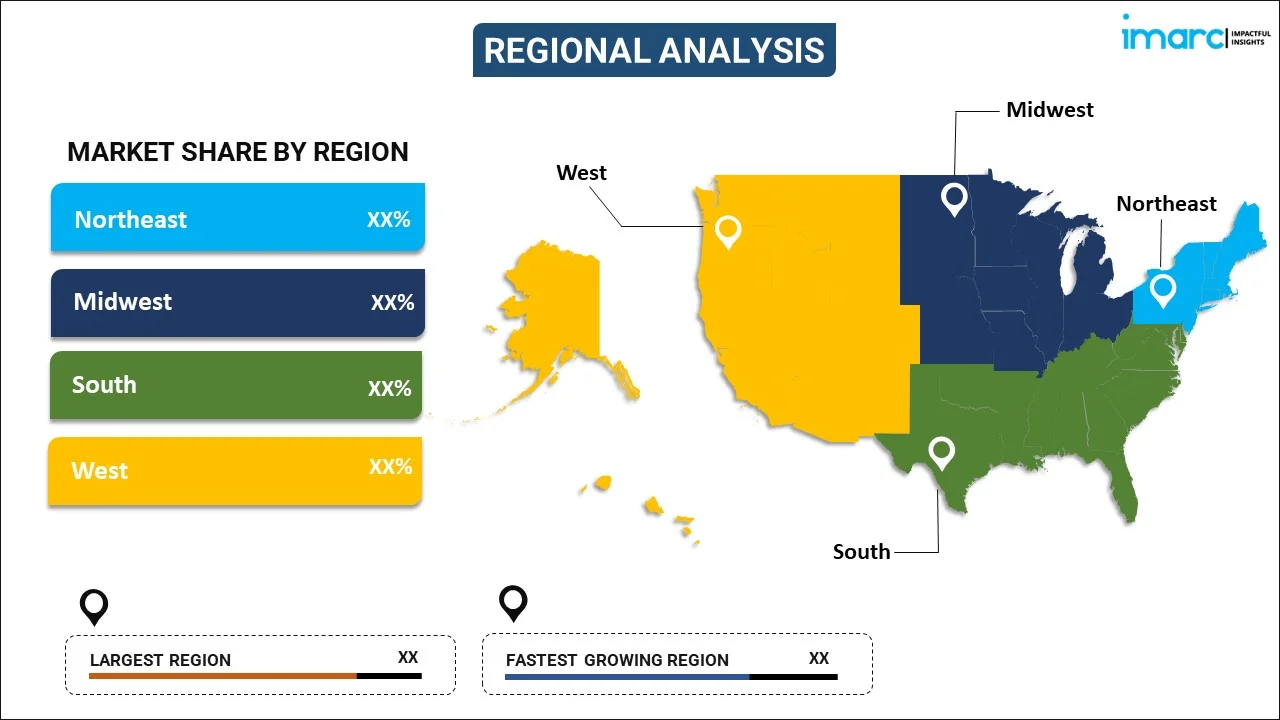
United States Food Enzymes Market Report by Type (Carbohydrase, Protease, Lipase, and Others), Source (Microorganisms, Bacteria, Fungi, Plants, Animals), Formulation (Powder, Liquid, and Others), Application (Beverages, Processed Foods, Dairy Products, Bakery Products, Confectionery Products, and Others), and Region 2025-2033
Market Overview:
The United States food enzymes market size reached USD 566.6 Million in 2024. Looking forward, IMARC Group expects the market to reach USD 870.6 Million by 2033, exhibiting a growth rate (CAGR) of 4.64% during 2025-2033.
|
Report Attribute
|
Key Statistics
|
|---|---|
|
Base Year
|
2024
|
|
Forecast Years
|
2025-2033
|
|
Historical Years
|
2019-2024
|
|
Market Size in 2024
|
USD 566.6 Million |
|
Market Forecast in 2033
|
USD 870.6 Million |
| Market Growth Rate 2025-2033 | 4.64% |
Food enzymes are biocatalysts that initiate chemical reactions to convert complex carbohydrates and fats into a digestible form. The primary sources of these enzymes include plants, animal tissues and microorganisms. Protease, lipase, amylase, pectinase, rennet and cellulase are some of the enzymes widely used in the food and beverage industry. They are primarily used in the production of bakery products, processing of cheese and starch, meat tenderizing and manufacturing of fruit juices.
Significant growth in the food and beverage industry in the United States is one of the key factors creating a positive outlook for the market. In line with this, cafés, hotels and quick serving restaurants (QSRs) extensively use food enzymes to impart innovative and exotic flavors to the dishes. Food and beverage manufacturers across the country also use these enzymes to improve the quality and increase the products' shelf-life. Moreover, changing lifestyles and increasing health consciousness among consumers is further contributing to the market growth. This has resulted in the rising demand for functional foods, which are fortified with natural food enzymes. Additionally, the utilization of innovative, genetically engineered food enzymes for industrial food manufacturing is acting as another major growth-inducing factor. These enzymes are also used by meat vendors to process and tenderize red meat, poultry and seafood products.
Key Market Segmentation:
IMARC Group provides an analysis of the key trends in each sub-segment of the United States food enzymes market report, along with forecasts at the country and regional level from 2025-2033. Our report has categorized the market based on type, source, formulation and application.
Breakup by Type:

- Carbohydrase
- Amylase
- Cellulase
- Lactase
- Pectinase
- Others
- Protease
- Lipase
- Others
Breakup by Source:
- Microorganisms
- Bacteria
- Fungi
- Plants
- Animals
Breakup by Formulation:
- Powder
- Liquid
- Others
Breakup by Application:
- Beverages
- Processed Foods
- Dairy Products
- Bakery Products
- Confectionery Products
- Others
Breakup by Region:

- Northeast
- Midwest
- South
- West
Competitive Landscape:
The competitive landscape of the industry has also been examined along with the profiles of the key players.
Report Coverage:
| Report Features | Details |
|---|---|
| Base Year of the Analysis | 2024 |
| Historical Period | 2019-2024 |
| Forecast Period | 2025-2033 |
| Units | Million USD |
| Segment Coverage | Type, Source, Formulation, Application, Region |
| Region Covered | Northeast, Midwest, South, West |
| Customization Scope | 10% Free Customization |
| Post-Sale Analyst Support | 10-12 Weeks |
| Delivery Format | PDF and Excel through Email (We can also provide the editable version of the report in PPT/Word format on special request) |
Key Questions Answered in This Report:
- How has the United States food enzymes market performed so far and how will it perform in the coming years?
- What has been the impact of COVID-19 on the United States food enzymes market?
- What are the key regional markets?
- What is the breakup of the market based on the type?
- What is the breakup of the market based on the source?
- What is the breakup of the market based on the formulation?
- What is the breakup of the market based on the application?
- What are the various stages in the value chain of the industry?
- What are the key driving factors and challenges in the industry?
- What is the structure of the United States food enzymes market and who are the key players?
- What is the degree of competition in the industry?
Need more help?
- Speak to our experienced analysts for insights on the current market scenarios.
- Include additional segments and countries to customize the report as per your requirement.
- Gain an unparalleled competitive advantage in your domain by understanding how to utilize the report and positively impacting your operations and revenue.
- For further assistance, please connect with our analysts.
 Inquire Before Buying
Inquire Before Buying
 Speak to an Analyst
Speak to an Analyst
 Request Brochure
Request Brochure
 Request Customization
Request Customization




.webp)




.webp)












